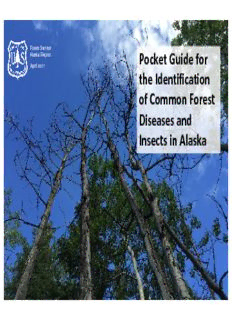
Pocket Guide to the ID of Forest Diseases & Insects in AK PDF
Preview Pocket Guide to the ID of Forest Diseases & Insects in AK
Pocket Guide for the Identification of Common Forest Diseases and Insects in Alaska Forest Service Alaska Region April 2019 Diseases and insects cause enormous volume loss and tree mortality to the forests of Alaska. They also play vital ecological roles by cycling nutrients, providing wildlife habitat, and enhancing forest diversity. This guide is designed to assist with the identification of the most common diseases and insects of trees in Alaska. It was produced as an aid for field-going crews. This document was produced by: Lori Winton, Stephen Burr, Robin Mulvey, Elizabeth Graham, & Garret Dubois Forest Health Protection, Alaska Region, USDA Forest Service Printed on waterproof materials On the cover: A debarked lesion of Aspen Running Canker; the brown tissue is necrotic, the greenish-yellow tissue is still healthy. On the back cover: Willow leafblotch miner damage. Mining produces necrotic tissues reducing photosynthesis 1 Root and Butt Rots 2 Root and Butt Rots Hosts:All tree species in Alaska. ID:Decayed roots and butts. Mushrooms, conks, or other fungal structures on the root collar or roots (nonpathogenic mushrooms and conks can also be found near tree bases). Uprooted trees have few remaining roots (root ball, root wad). In a root disease center, the direction the trees fall may be inconsistentwith the direction of prevailing wind. Remarks: Root diseases are the most damaging group of forest diseases in the U.S. The known root and butt diseases in Alaska are caused by internal wood decay (rot) fungi that may overlap with stem decay fungi. Butt rot fungi decay the heartwood at the base of the stem. Trees can live with butt rot for years or decades. Tree mortality usually occurs due to uprooting or snapping associated with the loss of structural integrity. 3 Armillariaspecies ArmillariaRoot Rot mycelial fans rhizomorphs David Shaw, Oregon State University David Shaw, Oregon State University David Shaw, Oregon State University David Shaw, Oregon State University 4 Armillariaspecies ArmillariaRoot Rot Hosts:All tree species in Alaska. ID:Thick, latex-like mycelial fans under bark and black shoestring-like structures (rhizomorphs) under bark and on surface of roots and/or lower bole are the best indicator. The mushroom sometimes occurs in clusters at tree base but is uncommon and difficult to identify. Top: honey colored, sometimes with dark brown scales. Bottom: white gills attached to both stalk and cap. Stalk: ring around stalk below gills. Damage: Growth loss, snapped trees, mortality. Advanced decay is white stringy rot, often spongy and wet. On hardwoods, often with gelatinous pockets. Remarks: Also called shoe-string rot and honey mushroom. Some species are bioluminescent! Armillariaspecies can form humongous clones and vary in their aggressiveness and ecological role; some are highly pathogenic, while others attack trees already stressed or killed by other factors. 5 Onnia tomentosa TomentosusRoot Rot Honeycombed decay 6 Onnia tomentosa TomentosusRoot Rot Hosts:Primarily white and black spruce; but also Sitka spruce and lodgepole pine. ID:Leathery mushroom < 4“ diameter, often has embedded litter; on ground attached to roots or tree base; found late summer and autumn. Top: distinctly felty, yellow-brown to rusty-brown with a blunt, rounded, yellowish- white margin. Bottom: creamy-white with small round pores(no gills). Stalk: thick central stalk has pores that run partway down and there is often brown felt along the portion closest to the ground. Damage:Mortality, uprooted trees with few intact roots, ; White pocket rot results in pitted to honeycombed decay of roots; look carefully for honeycombed roots on uprooted spruce. Stump incipient decay is pinkish to red-brown. Remarks: Canada’s neighboring Yukon Territory has conducted limited surveys that suggest more than 40% of trees were infected. Can be very difficult to diagnose. Conks often not present. Formerly known as Inonotus tomentosus. 7 Phaeolus schweinitzii Schweinitzii Butt Rot 8 Phaeolus schweinitzii Schweinitzii Butt Rot Hosts:Sitka spruce, white spruce, and hemlock; rare on shore pine in Alaska. ID: Large, annual, layered fruiting body; shelf-like on lower bole; circular and stalked with sunken center on ground. Develops on both live and dead trees/logs. Turns dark red brown and brittle when dead (resembles cow pie) Top: velvety, yellow to orange when young, turning brown with a olive brown to yellowish margin. Bottom: large, irregularly shaped pores, bright yellow to orange when young becoming greenish yellow, olive or brown; quickly bruises dark brown. Damage: Brown cubical butt rot, often extensive. Rapid loss of tensile strength, even at fairly early stages of decay, may lead to breakage on lower bole. Remarks: Also known as the cow pie fungus, velvet top fungus or dyer’s polypore. Can be used to create yellow, brown, and green dyes. Sometimes confused with Onniatomentosa. 9
Description: